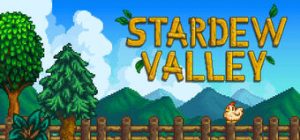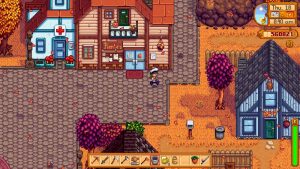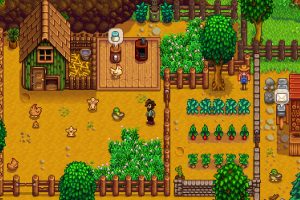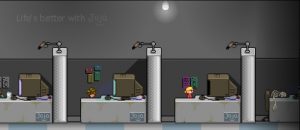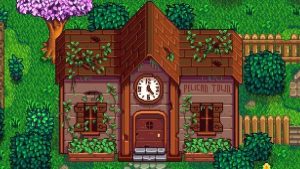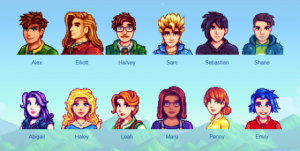Stardew Valley
A Look at Stardew Valley’s Feminist Values
by Megan Hanson
Stardew Valley took the gaming world by storm after its release in 2016. As an indie game produced single-handedly by its developer, Eric Barone, there was some speculation around the cause of its widespread popularity. I argue that the game’s universal appeal is in its compassionate, community-oriented values. Through non-competitive gameplay and a focus on self-sufficiency and kindness, Stardew Valley weaves a powerful feminist message about corporate exploitation and the importance of community.
To get a feel for the graphics and gameplay, please watch this three-minute trailer for the game! (click here) It explains the premise and shows a good range of the in-game activities.
Non-Competitive, Community-Based Gameplay
In contrast with many popular video games, Stardew doesn’t have a single competitive element. There’s no competing to sell your crops, no rush to find exclusive resources, and no player vs player combat. Even the multiplayer mode is all cooperation-based; you work together with your friends to run your farm. Instead of competition, the biggest focus of the game (aside from farming) is helping the other residents of Pelican Town.
The game subtly incentivizes community-building and cooperation through quests and rewards. The player makes friends with the NPCs (non-player characters) by learning what they like and giving them gifts. As you get to know different people, you learn their backstories and interests, and sometimes they’ll send you recipes or small gifts. Answering ‘Help Wanted’ ads helps you gain friendship points with the townsfolk, too, as well as a small monetary reward.
If you get to know one of the town’s twelve bachelor(ette)s well enough, you can get married and start a family, who will then help you run your farm.
There is some non-competitive combat in the game, as seen in the trailer: While exploring the mines, you have to defend yourself from hostile monsters you encounter along the way. Even this activity is framed as a service to the town—often the mayor or the local wizard will put out an ad requesting someone to slay monsters to keep the villagers safe.
One of the biggest goals in Stardew Valley is fixing up the abandoned Community Center. Soon after you embark on your first season as a farmer, Mayor Lewis tells you about the glory days of the old building and his hope that someday it can be a gathering place for the town again. Inside you discover little forest spirits called ‘Junimos’, who present a series of items you must collect to complete ‘bundles’. With each bundle you complete, you gain small rewards that help your farming progress and start magically fixing up the Community Center. Each set of completed bundles fixes part of the town’s run-down infrastructure, like broken bridges, a minecart system, and the defunct bus service. This game mechanic encourages you to contribute to the town’s well-being while helping you grow your farm and access new resources.
Stardew Valley’s lack of competitive elements reflects a growing market for creative, non-fighting games. Other popular games and franchises that make use of this niche include Harvest Moon, (one of the games that inspired Stardew), Animal Crossing, and even the creative and survival aspects of Minecraft. Stardew takes the elements that made those games successful and introduces refreshing, engaging gameplay and nostalgic graphics that make it appealing to players of all kinds. Rather than encouraging the player to engage in violence to win, it creates a narrative where compassion and generosity are the means to success. It also dramatically shifts away from capitalist profit and toward self-sufficiency and local community.
Anti-Corporate/Consumerist Messages
The closest thing to an antagonist in Stardew Valley is a company called Joja Corporation, and the game uses a variety of clever tactics to persuade the player of its awfulness. The game opens with a cut scene showing your character working in a dim, miserable cubicle at Joja, and then contrasts it sharply with the verdant farmland you receive upon your arrival in the valley. As you get more involved with the community and learn how to make a living off the land, Joja’s fingerprints appear on nearly everything. Pierre’s General Store is the supply shop in town, but Joja has its own store across the river. Townsfolk and shop owners will tell you about their struggle to compete with JojaMart prices or having to shop there out of necessity. Joja Cola, the company’s main product, is almost universally hated as a gift, a big hint at the town’s opinion of the company.
Inside the JojaMart, the colors are a dull, sterile blue and white, completely at odds with the warm tones of the local businesses, and the employees have dark circles under their eyes. Investigating the shelves reveals gross descriptions of synthetic, unhealthy products. The store’s nefarious-looking manager, Morris, is not available to befriend or even chat with—all he does is try to sell you an expensive membership. Nothing is untouched by Joja; fishing can turn up trash like Joja Cola cans or broken JojaNet CDs, implying a history of extensive pollution. There are even hints that Joja is a little too involved in your personal life—if you stay out too late or pass out from exhaustion, you might end up back home with a letter from Morris saying “a Joja team member found you incapacitated”, along with a bill for the “service”.
As mentioned above, one of the goals in the game is to collect items for ‘bundles’ to fix up the Community Center. If you decide to buy a JojaMart membership, however, the Community Center is replaced by a Joja warehouse. You can still get the infrastructure upgrades from the warehouse, but you don’t get small milestone rewards or friendship points; instead, you just purchase the rewards with a lump sum instead of completing bundles. It’s a much less fulfilling way to help the town, and deprives the townsfolk of a refurbished community space. The game does a very effective job at dissuading the player from siding with Joja, as seen in this Steam forum discussion: players “really [hate] the idea of going against…helping out the community center” (NinjaKlutzZ), and say doing so feels like “living knowing that you sold your soul to the devil” (PhilkIced). It’s very clear that Stardew is presenting “…a simple, country lifestyle over the capitalist and consumerist culture that the Joja Corporation takes advantage of… [It] seeks to remind players that white collar jobs and consumerist culture are not the only things worth striving for”, as explained by blogger coolcat809 in their review of the game.
Other reviewers have a different perspective on the messages in Stardew Valley. Blogger Gersande argues that it only serves to perpetuate capitalist ideals; “I am still turning the farm into a commercial, capitalist enterprise where at the end of the day I’m not trying to take care of my community but am trying to make “a living” from it. Just because I chose to sell…to Pierre instead of Joja Mart does not mean that I am actually bolstering the community economy.” They argue that restoring the Community Center is an independent transaction, and that “…there is little or nothing that is community-building or grassroots about the process”. I disagree with this analysis. As aforementioned, getting to know and care about the villagers is a huge part of the game; fixing up the Community Center is very clearly framed as a method of supporting them. Considering the villager’s statements regarding Joja’s negative impact, choosing not to support Joja is an act of resistance in itself. In the real world, individual choices like this are rarely the whole solution. But they are a start, and Stardew clearly shows the benefits of supporting local business. Upon completing the Community Center, Pierre is able to open his shop seven days a week instead of six, villagers hang out in the refurbished building, and the former JojaMart is converted into a movie theater, bringing new jobs to the economy.
Diversity, Kindness, and Feminist Values
It is clear that even the most fundamental aspects of Stardew are founded on feminist ideals. The game is inclusive of different gender expressions and romantic orientations: all clothing options and hairstyles are available whether you choose to have a male or female character,
and any of the twelve ‘romanceable’ characters are available to date, no matter which gender option you choose. (There is not an option to give your character gender-neutral pronouns; however, players have created mods that add this option.)
The gameplay itself even promotes self-care. Your character has an energy bar that depletes as you do farm activities, and it’s vital to keep an eye on your energy level to avoid passing out. Eating food can boost your energy, and more nutritious food provides more energy. It even encourages healthy sleeping patterns; in contrast to games like Minecraft, where you can go without sleep infinitely, Stardew requires you to get to bed before 2 a.m., otherwise you’ll fall asleep wherever you are (deep in the mines, for example) and lose money. Plus, if you go to bed past midnight, you won’t start with a full energy bar the next day.
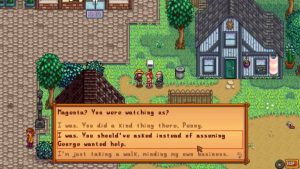 In terms of inclusivity, the game’s NPCs are a diverse group of characters on many levels. Within such a small cast, there are a wide variety of family units, levels of wealth and ability, and various ethnicities represented. But the labels you can fit the characters into are not what make them so compelling. As reviewer Cupcake Goes Rawr notes, they “lack the carefully studied “everyman” quality that you find in games with a larger team… Each NPC in Stardew is more unique and quirky than a carefully distilled cast meant to represent the full spectrum of diversity and inclusion could have managed”. As you befriend each of the different characters, a range of feminist themes pop up in their storylines. For example:
In terms of inclusivity, the game’s NPCs are a diverse group of characters on many levels. Within such a small cast, there are a wide variety of family units, levels of wealth and ability, and various ethnicities represented. But the labels you can fit the characters into are not what make them so compelling. As reviewer Cupcake Goes Rawr notes, they “lack the carefully studied “everyman” quality that you find in games with a larger team… Each NPC in Stardew is more unique and quirky than a carefully distilled cast meant to represent the full spectrum of diversity and inclusion could have managed”. As you befriend each of the different characters, a range of feminist themes pop up in their storylines. For example:
- One scene with George and Penny addresses bodily autonomy and etiquette for wheelchair users.
- Both Pam and Shane have storylines that tackle mental health issues and alcohol dependency.
- The value of community is heavily present in one of Linus’ events. Once you get to know Linus, the self-proclaimed ‘wild-man’ who lives off the land, you learn he sometimes dumpster-dives for food; the Saloon owner Gus makes it clear that he will help Linus and doesn’t want anyone to go hungry.
- Sam confides his fears for his father, who is deployed in a distant war; when his dad Kent returns at the start of Year Two, he suffers from PTSD as a result of his time in service.
Through this sort of representation, Stardew Valley encourages empathy and kindness towards all sorts of people. By giving the NPCs such complex, human backstories, Stardew gains a whole other dimension that really pushes it beyond its farming-simulator inspiration. The player has the opportunity to learn about types of people and situations that might vastly differ from their own lived experiences, and gain insight into other lifestyles. For me, this is what makes Stardew stand out. “It’s just a happy little farming game. Collect eggs. Make jam. But the stories linger,” as reviewer Alisha Karabinus says.
Stardew Valley isn’t a game I’ll be getting bored with anytime soon. With all the chaos happening in the real world, it’s pretty nice to escape to a peaceful countryside, especially when I play on a shared game with friends. What makes Stardew appealing is also what makes it an inherently feminist game; without any competitive elements, it promotes an anti-corporate, community-oriented lifestyle, where kindness is the best means to progress.
If you’re interested in playing Stardew Valley yourself, the game’s website has links to download or purchase it for consoles.
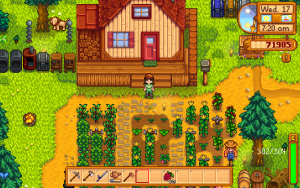
My farm on Stardew Valley.
Works Cited
Alisha Karabinus. “Growing Strong in Stardew Valley.” NYMG, January 17, 2017. https://www.nymgamer.com/?p=15812.
coolcat809. “A Critical Look at Stardew Valley.” Blog. Blog Boy (blog), April 27, 2017. https://coolcat809.wordpress.com/2017/04/27/a-critical-look-at-stardew-valley/.
Cupcake Goes Rawr. “Stardew Valley Has More Spirit Than Its Inspiration.” Medium (blog), August 15, 2016. https://medium.com/@CupcakeGoesRawr/stardew-valley-has-more-spirit-than-its-inspiration-a9c82535a34f.
Eric Barone (ConcernedApe). Stardew Valley Trailer. Trailer. ConcernedApe, 2016. https://www.youtube.com/watch?v=ot7uXNQskhs.
Gersandre La Flèche. “The Gentleman Farmer, Labour and Land: Ecocritical Possibilities in Stardew Valley.” Blog. Gersandre La Flèche’s Blog (blog), May 3, 2016. https://gersande.com/blog/the-gentleman-farmer-labour-and-land-ecocriticial-possibilities-in-stardew-valley/.
NinjaKlutzZ, and PhilkIced. “Side with Joja Mart, What Happens?” Discussion. Steam: Stardew Valley General Discussions, April 4, 2016. https://steamcommunity.com/app/413150/discussions/0/365163686051706947/.
Stardew Valley. ConcernedApe, 2016. https://www.stardewvalley.net
